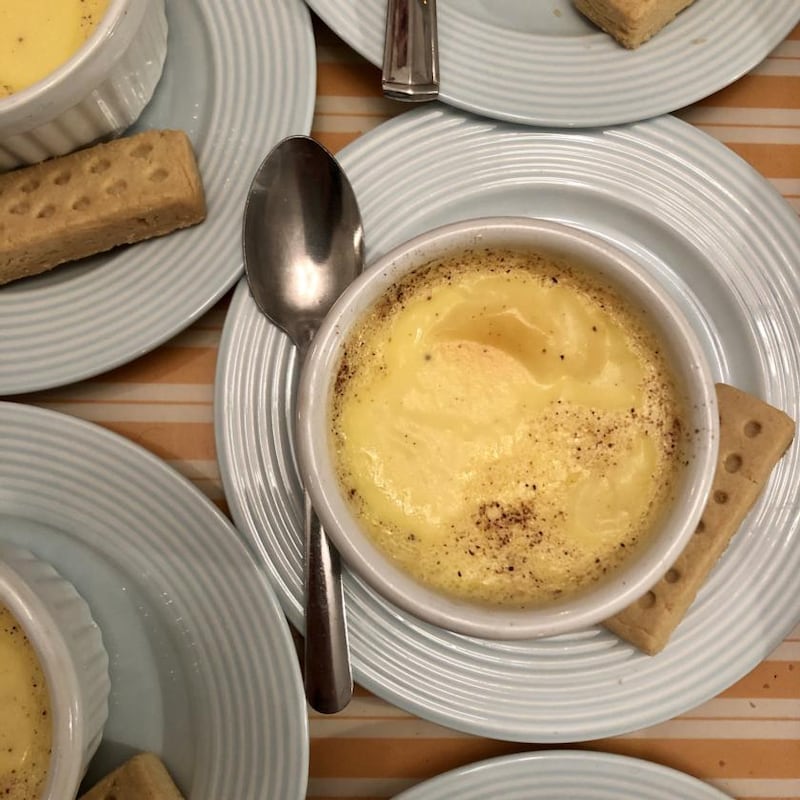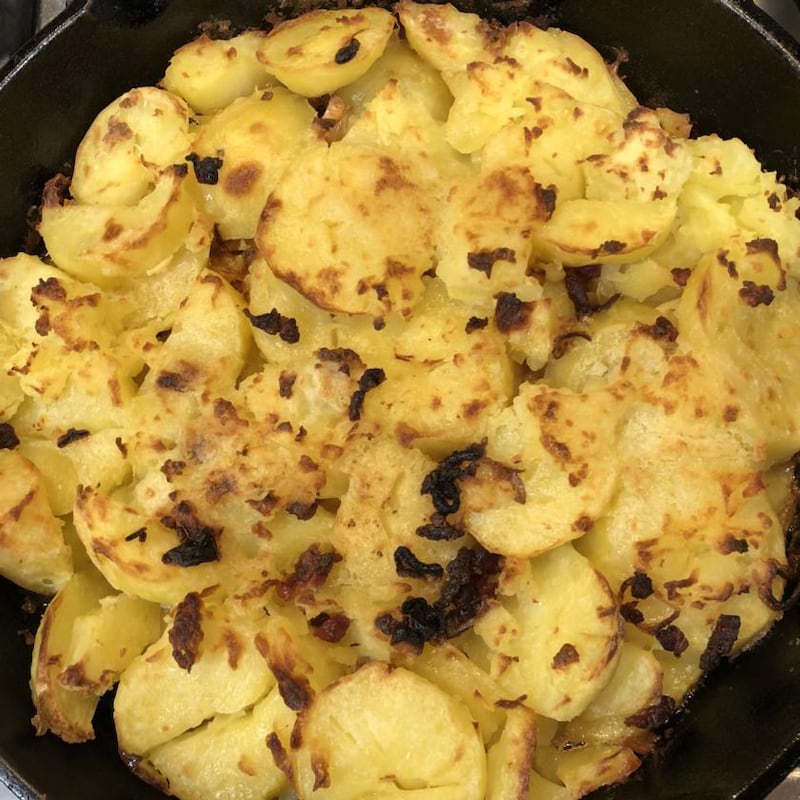Anyone lucky enough to own a copy of Full and Plenty, Maura Laverty’s classic cookbook, won’t need to be told it is no mere collection of recipes. It’s a little bit of social history, a deliciously gossipy short-story collection, a manual for adulthood and a home-economics textbook. There are hundreds of recipes in sections on everything from home-brewed elixirs to French cooking made easy, but to me they have always felt slightly beside the point.
My copy, above all, is an important piece of family history, a connection to a distant time and place and to a grandmother I didn't know very well in life. The Full and Plenty that has sat on every kitchen shelf in every house I've lived in belonged to my mother's mother, Maureen – and, judging by the yellowing pages, the shattered spine and the terse notes in the margin, it was her Ballymaloe, her Jamie Oliver, her Delia Smith and her Great British Bake Off rolled into one.
Having a healthy stock of recipes was something approaching a status symbol: they were shared around between trusted friends like tips on managing your cryptocurrency portfolio

It was also, I suspect, her means of imposing order on the chaos and frustrations of life in the early 1960s for a mother of five who also helped to run the family business. Recipes, for many women of that era, were a social currency all of their own, a subtle measure of your proficiency, capability and creativity. Having a healthy stock of them, ready to bestow on friends and correspondents, represented something approaching a status symbol: they were shared around between trusted friends like tips on managing your cryptocurrency portfolio. “Thank you for a most enjoyable Sunday evening,” writes one correspondent to Maureen, enclosing two handwritten recipes, for elderflower wine and elderflower champagne, by way of gratitude.
The real joy for me has always been these recipes – not the ones printed on its 473 pages but the ones stuffed between them, written on the back of envelopes or sometimes cut out of newspapers. There’s Maureen’s Christmas pudding 1949, a recipe older than my mother. And there’s her Swiss steak. (You sprinkle it with Bisto, pop it in the oven for an hour, and “serve with fresh veg and a bottle of red wine”.)
My favourite is her Devil’s food cake, mostly because of the note on provenance at the end. “I got this recipe [from] Miss O’Neill, a demonstrator for ESB, who got it from some ‘Church of Ireland lady’ who was a very good cook,” she writes in one of her notes to self. “I used to make it for the mission sale of work and the same lady bought it each year, a long time ago. Anybody that ate it said it was lovely.” And then, in an afterthought, lest a future reader thought she was getting notions, “MAYBE IT WAS DIPLOMACY.”
I also, through some quirk of fate – some wildly, wildly optimistic quirk of fate, as my culinary repertoire has extended for the past two decades to precisely four dishes, each of which gets trotted out roughly once a year – managed to inherit a cookbook from my other granny, my father’s mother, Chris. Her considerably less well-thumbed edition of Marguerite Patten’s Every Day Cook Book somehow made its way to me too.
I’ve never felt the same connection to Marguerite and her aspirational “emergency hors d’oeuvres”, her “jugged hare” this and her “grouse casserole” that, as I do to Maura. Maybe it’s because I grew up four minutes’ walk from Chris’s front door, and if I close my eyes I can picture her kitchen, a place where the Stanley was always lit, the sweet drawer in the white-and-green 1950s dresser was always full to bursting with Fry’s Chocolate Creams and Caramels and Mint Crisps, and there was usually a pan of sausages or a stew simmering on the stove – and I know that an hors d’oeuvre would never would have got within an ass’s roar of the place, no matter what class of emergency might have been looming.
The books are probably the first thing I'd rescue in a fire, after my children, the husband, the cats and a few items from my wardrobe. They're not about cooking. Good God, no
I can’t find the granny I adored anywhere in Marguerite’s uppity Supper Time Savouries (mussel titbits?), or her notes on cooking woodcock (“intestines delicious”; really, Chris?), except in the handwritten recipe inside the front cover for a pick-me-up, an emetic-sounding blend of orange juice, egg, milk, yeast, honey and a dash of sherry.
But it doesn’t really matter. The point of these books for me has never been the food. They are about memories, nostalgia and family. They are probably the first thing I’d rescue in a fire, after my children, the husband, the cats and a select few items from my wardrobe. They’re not about cooking. Good God, no.
Rosa, my 13-year-old daughter, has other ideas, however. She is an excellent baker of the great granny Maureen school, collecting her best recipes from her favourite cookbooks, and coming back to them again and again.
She bakes with her own granny, her friends and her little sister. She bakes alone. She bakes for special occasions, and she bakes just because. She bakes when she's happy and when she's sad. She's more Rachel Allen than Maura Laverty, but she rightfully decided it was a shame to keep treating her great-grandmother's cookbooks like museum pieces. Cookbooks, after all, are made to be used, the best ones – like our copy of Full and Plenty – until they fall apart at the seams. And so, on a recent weekend, she decides to bring back the 1950s.
Her efforts are only slightly frustrated by the imperial measurements and the often imperious tone, especially Marguerite’s, employed in the books, but she appreciates the practicality of it all and the no-frills, no-mollycoddling approaches in both. She likes the expectation that the reader will be able to figure certain things out for themselves (frequently, even the precise quantities) and the emphasis on method over fancy, expensive or hard-to-find ingredients or glossy images. Mostly, she has fun baking like it was 1959, exactly as her great-grannies used to.
MARGUERITE PATTEN’S BAKED EGG CUSTARD

It is good menu planning to serve an egg custard after a fairly substantial main course. In order that this shall be successful, remember:
1. Use the right proportion of eggs and liquid – too few eggs will give a custard that does not set.
2. Cook slowly – if steaming the custard or pudding then the water must be hot, but NOT BOILING. If baking, stand the custard or pudding in a tin of water, so this slows up the cooking process.
Ingredients
2 eggs
1tbsp sugar
¾pt milk
A little grated nutmeg
Method
Beat the eggs and sugar together. Pour over the hot but not boiling milk. Pour into a pie dish and top with grated nutmeg. Stand in another container of cold water. Bake in a very slow oven at 135 Celsius for 1¼ to 1½ hours until quite firm. For a less firm custard, use only 2-3 eggs.
Our verdict
A foolproof and delicious old-school take on creme brulee. Rosa baked them in individual ceramic ramekins and served them straight from the oven with a piece of shortbread. She followed another Marguerite recipe for meringues to use up the leftover egg whites.
MAURA LAVERTY’S EGGS IN A NEST
Ingredients
1lb mashed potato
5tbsp hot milk
½tsp yeast extract
2tbsp margarine [we substitute butter]
2tbsp chopped parsley
1tbsp onion
4 eggs
2tbsp breadcrumbs
1tbsp butter
½tsp salt
Pinch of pepper
Method
Blend yeast extract with hot milk. Melt butter in milk and beat into mashed potatoes. Add seasonings, chopped onion [we leave out the onions at the request of younger diners] and parsley. Mix well. Place mixture in a greased baking tin [we use a cast-iron skillet] and press four large hollows in it with the back of a spoon. Sprinkle the top with breadcrumbs and dot with butter. Bake in a moderate oven [160 Celsius] until the eggs are firm but not hard.
Our verdict
Only a bit trickier than our usual Sunday brunch of poached eggs on toast but worth every second of faffing. This is the biggest hit of the weekend of 1950s cooking. Even the non-egg-eater enjoyed it. The non-egg-eater also devours the baked egg custard, so the 1950s may be bringing him around.
Smart brunch destinations should take note of this one; it's hard to imagine a more effective Sunday-morning cure than this oozy, carby, eggy feast. We serve it with sausages and beans rather than mimosas, as we are channelling great-grannies, not Sarah Jessica Parker.
MAURA LAVERTY’S LYONNAISE POTATOES

Ingredients
3tbsp bacon fat
3 cups chopped boiled potatoes
Salt and pepper
1 small onion
¼ cup milk
Method
Melt the bacon fat in a hot frying pan [we use lardons instead, and leave them in]. Add the boiled potatoes. Sprinkle with a teaspoon of salt and a pinch of pepper plus the onion, finely chopped. And the milk and cook slowly, without stirring, until well-browned on underside. Invert on a large plate and return to pan to brown other side. Fold over like an omelette and serve at once.
Our verdict
Sunday dinner is roast lamb, and neither Maura nor Marguerite is able to offer much variation on the usual method of roasting it, so Rosa innovates with the obligatory spuds instead, using this recipe from Full and Plenty. We imagine this is the kind of thing Great-Granny Maureen might have served on a Sunday evening in 1976 to so impress her guests that they would send her recipes for elderflower champagne. This crunchy, moreish, bacon-infused hash brown goes down very well, including with the non-bacon-eater, who may or may not also be the non-egg-eater.
MAURA LAVERTY’S GINGER SPONGE
Ingredients
4oz brown sugar
4oz margarine/butter
1tbsp golden syrup
1 egg
6oz flour
½tsp ground ginger
½tsp bread soda
¼pt sour milk [we use buttermilk]
Method
Cream butter and sugar. Mix together syrup and beaten egg. Sift flour with ginger. Blend soda with milk. Add milk alternately with flour to creamed mixture. Bake one hour in well-greased tin in 190 Celsius oven.
Our verdict
Less sweet than most modern cake recipes, and a bit bottom heavy as the golden syrup sinks to the bottom of the cake tin, but this makes for a lovely lunch-box addition. Next time, we'd probably use more ginger.

















